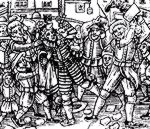John Lambe facts for kids
John Lambe (born around 1545 – died June 13, 1628) was an English astrologer and a doctor who wasn't officially trained. By 1625, he became a special advisor to George Villiers, 1st Duke of Buckingham, a very powerful person in England at the time.
Contents
Who Was John Lambe?
We don't know much about John Lambe's early life. He worked as a tutor teaching children to write in a place called Worcestershire. After about 1600, people started to know him as a "cunning man." This meant he was thought to be good at astrology and magic.
Lambe called himself "Doctor Lambe," even though he didn't have a real doctor's license. He told people he could tell their futures, find out what diseases they had, stop bad magic, and even find things that were lost or stolen using his crystal ball. Some people also whispered that he could do powerful magic like summoning spirits. He was active in the London area from about 1608 to 1628.
Lambe's Connection to Power
Before 1625, John Lambe caught the eye of George Villiers, 1st Duke of Buckingham. Villiers was a close friend and advisor to King Charles I. Soon, Lambe became the Duke's personal advisor.
People had different ideas about Lambe. Some thought he was just a fake and didn't have any real powers. Others truly believed he had magical abilities. These people even called Lambe "the Duke's Devil." They worried he was using magic to control Duke Villiers, who then influenced King Charles.
At this time, King Charles was not very popular because of his decisions about wars and how he ruled. A popular saying at the time showed how people felt:
- Who rules the Kingdom? The King.
- Who rules the King? The Duke.
- Who rules the Duke? The Devil!
Trouble and His Death
Many people in London started to share strange stories about Lambe. They believed he had "demonic" or "devilish" powers. One famous story, written down later by Richard Baxter, said that Lambe once showed off his powers. He supposedly made a tiny tree appear in a room, along with three tiny woodsmen who chopped it down. One person supposedly took wood chips from the tree, but they caused bad storms at his house, so he got rid of them.
Some people didn't believe these stories and called Lambe a "fake" and an "impostor." But many others were sure he was a dangerous magician.
Public Anger and Execution
Scared Londoners tried several times to punish Lambe for practicing black magic. However, because King Charles and Duke Villiers were so powerful, these attempts usually didn't work.
In 1627, Lambe was accused of a serious crime. He was sentenced to death. But because of his powerful friends, he managed to delay his execution for several months. Eventually, the people of London became very angry and afraid. They were tired of Lambe getting special treatment.
On June 13, 1628, an angry crowd attacked him as he was leaving a theatre. The mob killed him. No one was ever punished for his murder.
Lambe in Stories and Books
John Lambe's life and death inspired many stories and plays. An unknown writer published a book about him in 1628 called A Brief Description of the Notorious Life of John Lambe. A play called Doctor Lamb and the Witches came out in 1634. People also wrote many songs and poems about him.
Later writers also mentioned Lambe in their books. These included Isaac D'Israeli's Curiosities of Literature and Sir Walter Scott's Letters on Demonology and Witchcraft. He is also mentioned in Neal Stephenson's novel, Quicksilver.


